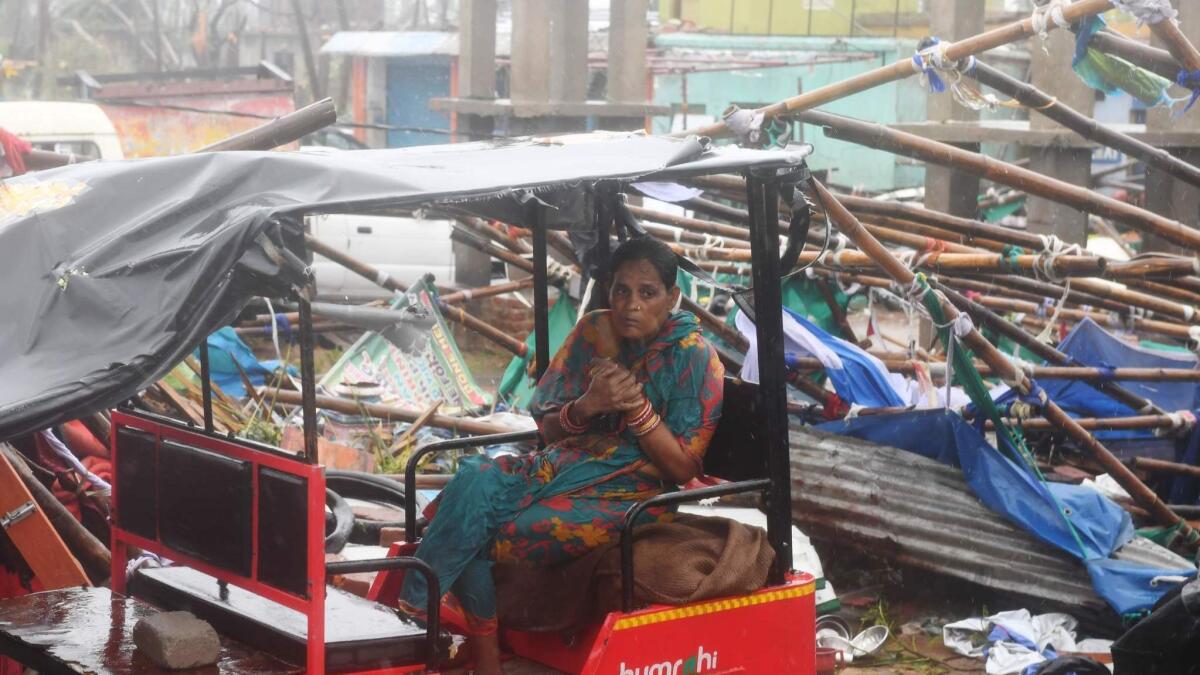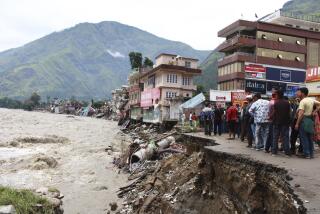Cyclone Fani lashes India’s east coast; storm’s power is felt as far away as Mt. Everest
Reporting from NEW DELHI — Cyclone Fani tore into India’s eastern coast on Friday as a Grade 5 storm, lashing beaches with rain and winds gusting up to 127 miles per hour and affecting weather as far away as Mt. Everest as it approached the former imperial capital of Kolkata.
The India Meteorological Department said the “extremely severe” cyclone in the Bay of Bengal hit the coastal state of Odisha around 8 a.m., with effects that reached across the Asian subcontinent.
The forecast called for dust storms in the desert state of Rajasthan bordering Pakistan, heat waves in the coastal state of Maharashtra on the Arabian Sea, heavy rain in the northeastern states bordering China and snowfall in the Himalayas.
Around 1.2 million people were evacuated from low-lying areas of Odisha and moved to nearly 4,000 shelters, according to India’s National Disaster Response Force. The military was placed on high alert. Odisha Special Relief Commissioner Bishnupada Sethi said the evacuation effort was unprecedented in India.
By Friday afternoon, Fani had weakened to a “very severe” storm as it hovered over coastal Odisha and was forecast to move north-northeast toward the state of West Bengal by Friday evening.
In Bhubaneswar, a city in Odisha famous for an 11th century Hindu temple, palm trees whipped back and forth like mops across skies made opaque by torrents of rain.
It is a “very, very scary feeling,” said resident Tanmay Das, 40, who described “the sound of wind as if it will blow you away.”
Most of the area’s thatched-roof houses were destroyed, and there was no electricity.
The national highway to Puri, a popular tourist beach city with other significant Hindu antiquities, was littered with fallen trees and electricity poles, making it impassable. A special train ran Thursday to evacuate tourists from the city.
The airport in Kolkata, the capital of West Bengal, closed from 3 p.m. Friday to Saturday morning, and rail lines were closed.
At least 200 trains were canceled across India.

The storm hit in the middle of India’s six-week general election, with rain forecast in Kolkata forcing political parties to cancel campaign events.
The National Disaster Response Force dispatched 54 rescue and relief teams of doctors, engineers and deep-sea divers to flood-prone areas along the coast and as far afield as Andaman and Nicobar Islands more than 800 miles east of mainland India in the Bay of Bengal.
Up to four inches of rain were expected in much of Sri Lanka, the island nation off the eastern tip of India.
More than 1,430 miles away on Mt. Everest, some mountaineers and Sherpa guides were descending to lower camps as weather worsened at higher elevations.
Hundreds of climbers, their guides, cooks and porters huddled at the Everest base camp, according to Pemba Sherpa of Xtreme Climbers Trek, who said weather and visibility was poor. May is the best month to climb the 29,035-foot Everest when Nepal experiences a few windows of good weather to scale the peak.
On India’s cyclone scale, Fani is the second-most severe, equivalent to a Category 3 hurricane.
Sethi, the special commissioner in Odisha, said communications were disrupted in some areas, but no deaths or injuries had been reported.
In the state of Andhra Pradesh just south of Odisha, Fani snapped some electricity poles in two and toppled others. In the Srikakulam district, where around 20,000 people were evacuated, thatched-roof houses collapsed and fishing boats were smashed into shards.
Still, no deaths or major damage was reported, district official J. Niwas said.
In Bangladesh, about 400,000 people were evacuated to shelters. The storm was on track to cross the country’s vast southwestern coastal region by midnight.
Local media reports said at least 10 villages had been flooded in the coastal Patuakhali district in southern Bangladesh.
Aid agencies warned that more than 1 million Rohingya from Myanmar living at refugee camps near the coastal district of Cox’s Bazar were at risk. Hillol Sobhan, local communications director for the aid group Care, said it had emergency supplies for refugees.
Emily Schmall reported from New Delhi. Associated Press writers Omer Farooq in Hyderabad, India, Julhas Alam in Dhaka, Bangladesh, and Binaj Gurubacharya in Kathmandu, Nepal, contributed to this report.
More to Read
Sign up for Essential California
The most important California stories and recommendations in your inbox every morning.
You may occasionally receive promotional content from the Los Angeles Times.










